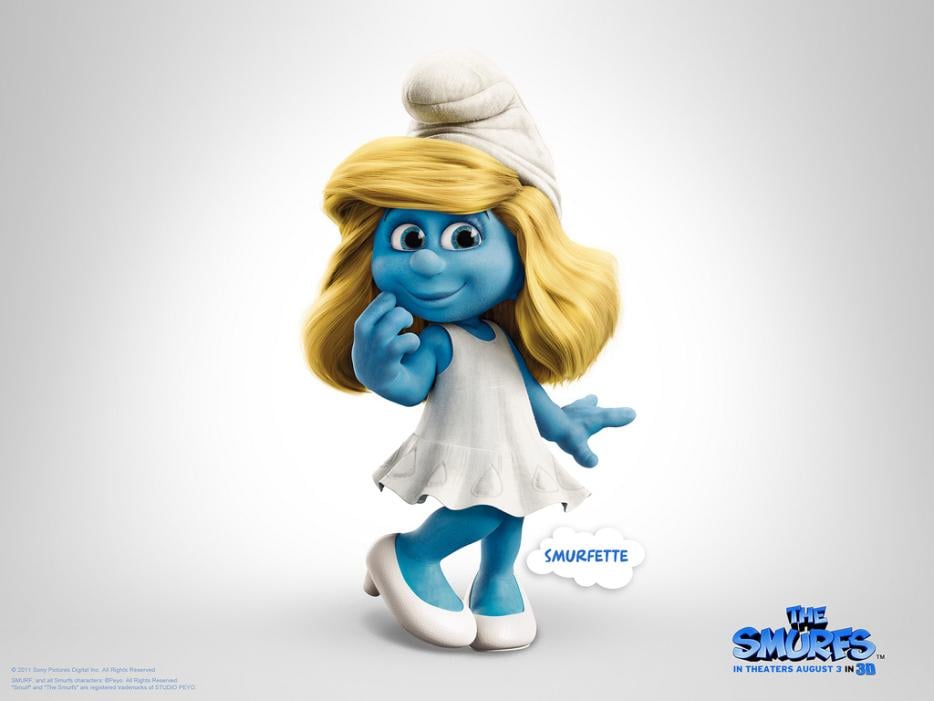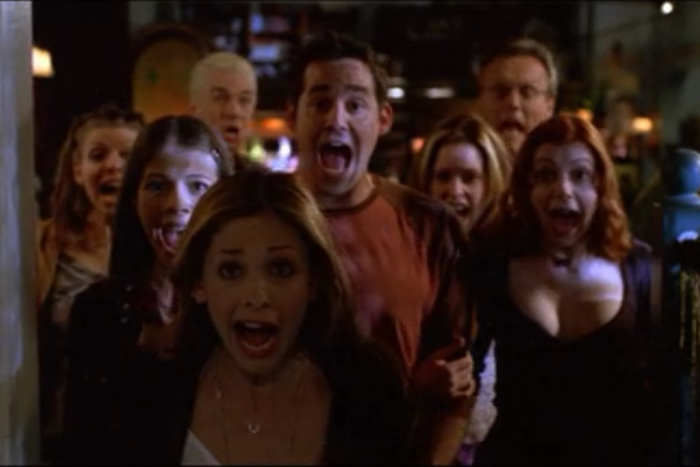When we were kids, my brother collected plastic Smurf figurines. While they were all fundamentally the same (blue body, white pants and white hat, except for Papa Smurf, who sported a red hat and white beard), each had different accessories based on their archetypal traits. Vanity Smurf held a mirror and had a flower in his cap; Handy had a hammer; Brainy had little glasses and a book tucked under his arm.
And then there was Smurfette. Different figurines depicted her engaged in a variety of activities, but it was always her: Blonde hair and a flowing white dress. Long eyelashes painted on. The only female of the clan. Fought over, lusted after. Chaste. Perfect. Pure.
Critics have noted the many social problems with Smurfette as a character: how she perpetuates a virgin/whore paradox; how, as the only female in a society of men, she tokenizes women’s identities and sets them up necessarily in relation to the dominant patriarchy. There’s even a fan theory that argues Smurfette was created to assuage homophobic fears among consumers of the comic and confirm for them the heterosexuality of the Smurfs (well, maybe not Vanity). In short, Smurfette is, as the saying now goes, problematic.
God, how I wanted to be her.
But Smurfette didn’t begin her life as a pure fantasy object. Initially, she was conjured through the magic of the evil wizard Gargamel, forged out of clay in an attempt to incite chaos and destroy the all-male Smurf population, a golem sent to infiltrate a peaceful community rather than protect it. And according to the official blurb that appears on almost every site hawking Smurf collectibles, she was originally a brunette with “a big nose and wild hair.” Smurfette, it turned out, at least at first, looked a lot like me. That is to say: Jewish. No wonder she spelled such trouble for the men of Smurf Village.
*
The “evil brunette” is a well-worn archetype, if not always articulated as such: Snow White’s Evil Queen, Maleficent, Catwoman. Even when Snow White is herself portrayed as brunette, there’s something more severe about her nemesis’s locks—hooded, widow’s peaked, framing a sharp face full of hate. And while these women are wicked and dangerous, it’s not lost on us, even at a young age, that they carry a deep sexual power: the Evil Queen seducing the Huntsman to kill for her, Catwoman afflicting her enemies with a crippling desire that fogs their mind before she destroys them.
But if the evil brunette is ubiquitous in children’s stories and comic books, Smurfette, introduced in 1966 by the Belgian artist Peyo who created the Smurfs eight years earlier, seemed to piggyback not only on age-old anxieties about female sexuality, but specific stereotypes of Jewish female sexuality at a time when the world (and particularly Europe) was still reeling from a confrontation with its own dark demons of prejudice and hate against that particular community.
I didn’t grow up in mid-century Europe, but I was still hyper-aware of Smurfette’s origins, perhaps because, from a very young age, I could sense that the world saw my sexuality as a dark-haired, Jewish woman in a way I couldn’t control. As early as middle school I was made aware that my wild hair, big nose and big ass were signals to men that I must be a particular kind of sexual being. While my more culturally ideal-looking peers (blonde, thin) collected the most ardent admirers, I got the lion’s share of lewd comments, the bulk of off-color jokes, a higher-than-average number of ass-grabs in the hallway. Not that any young girl is immune to inappropriate behavior from young men, but it seemed as though, by looking the way I did, I was tacitly signaling complicity in this sort of aggressive sexuality.
That perception has persisted into adulthood. I’ve been called “feral” by strangers on multiple occasions, been told by more than one man that I “couldn’t control myself” sexually when I was doing nothing more than sitting next to them. One man not otherwise prone to conspiracy theories or ghost stories once told me—scout’s honor—that evil spirits were casting a spell on him, forcing him to be sexually aroused by me, while I sat fully clothed in a chair across the room. It’s enough to make a girl wonder if she doesn’t actually possess some occult power no one told her about after all.
That popular description of Smurfette goes on, after mentioning her “big nose and wild hair,” to say that she “didn’t originally look like much.” It’s a strange addendum to such a specific description—implying, of course, that she wasn’t particularly attractive to men, the “much” toward which women are expected to strive. The sentence contains the entire paradox of the stereotypical-looking Jewish woman’s sexual identity: we’re told at every turn—by the media, by our peers, both men and women, by art—that our femininity is “less than” while simultaneously hearing that we are heightened sexual beings. It’s as though to keep the rest of their women pure, they must keep a subset of them dirty, a place to put their angry desire.
*
Our “whiteness” cannot be discounted in this calculation. Not all Jews are white, of course, but the predominant western notion of the Jew as a “white other” is the primary one underlying Smurfette’s identity (she was dark-haired, yes, but still blue, like the other Smurfs). It’s a complicated identity shared by millions of Jewish women since the Diaspora scattered us throughout Europe; we integrated into the local populations, had babies, and became “white,” but never quite. The Atlantic addressed this complicated question last November in an article teasing out the historical and cultural assumptions and challenges to Jewish whiteness. The article was met with much anxiety by people on all sides of the question, from Klansmen such as David Duke, offended that the question was even up for debate (“NO—JEWS ARE NOT WHITE!” he tweeted), to Jews and others who feared that simply asking would lead down the familiar slippery slope of dehumanization. But it would be disingenuous for a Jew not to acknowledge the tension between our undeniable white privilege at this point in history and the tenuous and provisional basis upon which this privilege has been granted. As Jewish women, our “whiteness” and “otherness” are part and parcel, conjoined sources of both titillation and trickery. Our beauty, even when palpable, is at root a deception—a spell cast by a sorcerer, a poison perfume, a hoax, a con, a lie.
Schindler’s List is a difficult movie to watch at almost every turn, but as a Jewish woman who has grown up with that unnamed sensation that our bodies are a battleground for men’s darkest desires, the brutal sexual assault of Helen Hirsch in the film is both validating of something we’ve known and felt our whole lives and chilling in its stark representation of the very real danger of that hunger. The Nazi Amon Goeth in one moment expresses his desire to “reach out and touch” the object of his desire and, in the very next, denies her personhood. “Is this the face of a rat?” he asks as he tenderly pulls her hair away from that face. And then, as he is about to kiss her—to violate her, but with such tenderness—he stops. “You Jewish witch. You nearly talked me into it.” Not with her words, for she has been silent, but with her mere existence, with her seductively slight “otherness” that made him wonder, what would it be like? What dark power might I unleash in her? In myself? And then, for nearly causing him to succumb to that power, he beats her.
The ironic truth of Helen Hirsch (a composite of two different maids who served in Amon Goeth’s home), of those evil queens and comic book villains, of Smurfette, is that they are all fictions created by men, either within a story itself or through its telling. They are created out of the fears and desires of men, and in their creation become a justification for imposing those fears and desires on real flesh and blood women. I’m not criticizing Spielberg for reinforcing this belief by showing it on screen—holding a mirror to this dark reality is an unavoidable part of making art about it—but it’s telling how many YouTube videos you can find of montages of Amon Goeth’s and Helen Hirsch’s scenes from the movie set lovingly to music. They all contain his abuse, yes, but they linger, too, as Goeth himself does, his hand on her breast, his mouth close to hers. As though what we are watching is a kind of unconventional romance rather than sexual violence.
*
As Gargamel prepares the magical potion from which he will conjure Smurfette, his incantation begins:
Sugar and spice but nothing nice
A dram of crocodile tears
The tip of an adder’s tongue
Half a pack of lies (white of course)
That she is made of the same primary ingredients (sugar and spice) as a “natural” woman, but is somehow devoid of the all-encompassing “niceness” that such ingredients would otherwise engender, is the cornerstone of the deep anti-Semitic allure of the Jewish woman. She looks like a woman. She feels like a woman. But her tears are fake and her words are lies (but white, of course, to mask their deception). She is no true woman, and for that she must be punished.
But Gargamel overshot in his calculations for that original big nosed, wild haired Smurfette. She messed with the Smurfs’ stuff, was sexually aggressive, yelled—the Smurfs found her more annoying and repellant than alluring. This, too, is an outcome Jewish women recognize: on the other side of the coin of the overt sexualization we face is the anxiety we provoke for being too strong, too confident, too loud, too bold. Often, whether or not men will let us get away with this brashness has to do with how easily they can sexualize it, so the Nanny gets a pass while Roseanne doesn’t, despite the fact that both exhibit those stereotypically Jewish woman’s traits: the sarcastic humor, the bossiness, the obnoxious laugh. Perhaps if Gargamel had just made Smurfette a touch more zaftig, his plan would have worked.
But Papa Smurf saw through Gargamel’s scheme and, with his own powerful magic, transformed Smurfette into the coy, beautiful, button-nosed blonde we all know and love today. Gargamel might have preyed directly on the Smurfs’ fears of the other, but Papa Smurf, in transforming that other into something inert, innocuous, something “same,” told them they were right to have been afraid in the first place.






